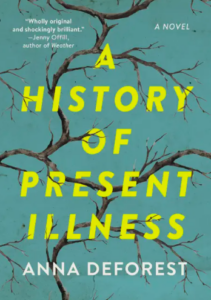— On the Work of Palliative Care

Anna DeForest Wrestles With the Calculus of Whether a Life Is Worth Living
By Anna DeForestIt has never been obvious to me that life is worth living. Throughout my medical training, where we have ample exposure to the tools of psychiatry, the taxonomy, I have considered that this disposition may be an illness, a disorder of mood or personality, or a maladaptation secondary to the traumas of my upbringing. But try as I might I cannot seem to be otherwise.
For almost a decade now my life has been in medical training, which is schooling that is also labor, for five years paid but the first four I paid for, and part of what they train us to do at these elite institutions is to be leaders in whatever fields we go into. We are made to practice giving academic talks, and whenever it is my turn, almost without meaning to I start talking about Rene Descartes, about thinking in relationship to being, about how wrong he was and how fucked up the world got, or I’ll talk about neuroscience and free will and confabulation, and I wonder if people with psychiatric illness feel the way I feel when I give these talks, the comforting grip of an ultimately ineffable concern.
The title of the training I have just wrapped up is Hospice and Palliative Medicine. Hospice means a roadside inn for pilgrims and indigent travelers. Palliative means more concerned with the experience than the reason it happened to occur. It is very important to the people who advocate for the field of palliative medicine, for its funding, legitimacy and worldwide integration into medical practice, that we always stress at every public opportunity that palliative care is for the living. Of course we are all of us dying, but their concern is worth a note. Because doctors care poorly for patients who are on the way out, and they wait too long to talk with the dying about death.
On the spectrum of death, unless you are to die instantly, in your sleep, say, or as my father did recently, in a chair in front of the television, so suddenly you do not even have time to rise, to try to get to a phone, so shocking and abrupt it can hardly register for you, the participant, the decedent, as having any quality, a good death requires a little bit of time—to rest, to reflect, to say the four things they say it helps to say: I am sorry, I forgive you, and the other two I forget. Hospice, though etymologically a place, is in modern usage a philosophy of care you can receive in your home or a nursing home or a hospital or anywhere, a team of nurses, doctors, social workers, chaplains and others who help you navigate the process of becoming dead.
Once on hospice, you stop receiving treatments that slow down the dying process and your care is focused on medications, practices and routines that can make your experience at the end of life less unpleasant. Palliative care, distinct from hospice, is a broader concern for anyone in a body enduring illness, a team performing symptom-focused assessments on anyone whose health is at times at odds with their quality of life.
Doctors care poorly for patients who are on the way out, and they wait too long to talk with the dying about death.The first person I ever saw die, and the second, and the third, were people in late age, their seventies or eighties, who died of cardiac arrests in the hospital. It goes like this: A call goes out overhead and a team comes at a run through the halls of the hospital, to where whoever found the patient pulseless is already over them, performing chest compressions. The body is stripped, legs and arms each a separate place, a project, someone placing a new line or stabbing for an arterial blood gas. The air fills with a tension you could tell yourself is excitement, although in tenor it is more like watching someone being arrested, surrounded, attacked. Every action argues for itself, right on the line of brutality.
Even before I saw all this, I often feared my heart would stop, mostly when it was night and I could not sleep. I would listen to my heart beat and beat, willing another, on and on and on. One of the unit physicians, when he learned I was not even enrolled yet, still in my first line of work, adjuncting in an English department, begged me to stay where I was. This job, he said, it eats your whole life, it is terrible. I can only guess what he meant, that his hours were long and his life and work not clearly delineated, that whatever he had imagined that his life would be like here, he had been wrong. The patients with heart failure were unfixable, noncompliant, always coming back.
Years later, I had finished medical school and was resident, training as a specialist in disorders of the brain. The patient was well-appearing, able-bodied, mid-fifties, a construction worker presenting with a few weeks of dizziness. An MRI showed small bright lesions all over his brain, a shower of metastasis. The word innumerable is never one you want to hear from a doctor. A pan CT showed the likely source of the mets, a large chest mass concerning for lung cancer. He had no idea, no other symptoms, just a little lightness in the head.
What does this mean, he asked, and his doctor, the attending physician who was my boss, told him he would have to wait, to see a number of specialists: the interventional radiologist, who would biopsy the lung mass; the medical oncologist, who would match the tissue sample to a course of chemotherapy; the surgeon, who would tell him his tumors are inoperable; the radiation oncologist, who would blitz his brain and chest with radiation.
He waited for days in bed as we coordinated the other doctors. The teams came and went, each saying its piece, in long speeches of words that made sense one by one but kept not adding up to anything. I had been taught not to tell him much, and it was true, we wouldn’t know the whole picture until after the biopsy, until the tissue was sent for tumor markers, and the treatment course sketched out. What I wonder, he said to me one afternoon when I was at the bedside, is why no one will just tell me that this is really bad.
One reason he never quit smoking was he was afraid of gaining weight. He didn’t want to get diabetes, which is the disease that killed his father around his same age. On the bloodwork we sent before his scans came back we found out that he had diabetes anyway. When I told him this, he laughed, and we shared the cannoli his wife brought in from their favorite Italian bakery. It is bad, I told him. It is really bad. He died, he did, a few months later.
As soon as there are choices to make, it is reasonable to talk about goals and values, because the math you do is about what makes your life worth living, what your life is not yours without.There is a stance that appears most in medical-school application essays that the purpose of medicine is to relieve human suffering, but it is truer to say, in Western medicine, that the goal is the prolongation of life. Nothing wrong with that, on its face, in some cases, though it may be reasonable to wonder, since everyone dies, what is the cumulative effect on medical practitioners, our hearts and heads, that we miss our goal in every case; a failure rate of one hundred percent.
But for you, for now, you have high blood pressure, high cholesterol, so take this pill to bring it down so that it doesn’t give you a stroke or kill you. If the cost is low and the benefit is high, the choice is clear, but in chronic illness and in life-limiting illness we find a need to add a little background math: this treatment, say it is whole-brain radiation, will prolong your life, and the cost of that prolongation is, say, aging your brain by forty years. This treatment, a percutaneous endogastric tube, will prolong your life but you will never be able to eat food by mouth again. As soon as there are choices to make, it is reasonable to talk about goals and values, because the math you do is about what makes your life worth living, what your life is not yours without. And this is the work that palliative care is about.
What is it, exactly, that you want me to do? The woman who was asking had metastatic cancer in her abdomen. Yesterday we told her that she had no options left for treatment. With her permission we shared a prognosis of weeks to a few months. Her face didn’t move as the news broke. She looked off to the left at the wall. And someone gave the speech on the philosophy of hospice, and she shared a hope to go home. It is the next day, with the logistics all already in process, that she asks.
What am I supposed to say now, what am I supposed to be thinking about? I can’t tell you how everyone I meet feels about the things we tell them, though young in this work I have seen a few trends. And something I see a lot is people who feel that their lives got away from them, they were always just watching, as from the station looking at faces flicking by on a moving train, and what is left to them now in the time they have left is only fear and suffering of unclear significance. What do I do with a thing like that? I hear it, and I help where I can.
What I am always saying in my Descartes speech is that we are not what we think, but we become what we are doing. I am worried about what this means for the doctors. Whenever I am lost, I try to stop moving, in case I am running off again in the wrong direction. It is never too soon to sit down and map out our values, to consider if we want to end up in the place where we are going. No, not yet, we aren’t there yet, says the oncologist. This is just a bump in the road.
________________________________________

Complete Article ↪HERE↩!






